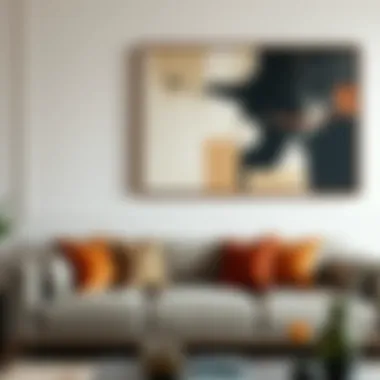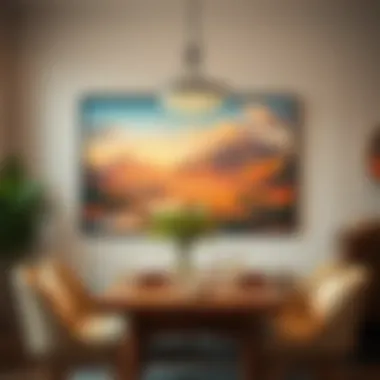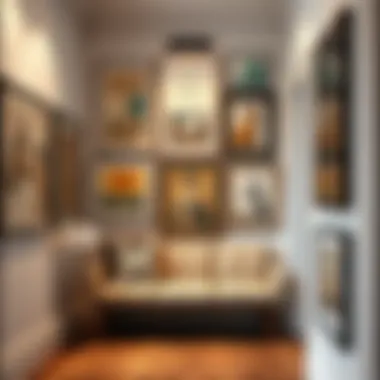Large Decorative Wall Pictures: Transform Your Space


Intro
Large decorative wall pictures serve as much more than just adornments on a wall; they are transformative elements that can utterly change the feel of a space. These art pieces act as visual anchors, commanding attention and drawing the eyes of anyone who enters the room. Whether you're in a cozy living room or an expansive hallway, the right wall art can reflect personal taste while enhancing the overall aesthetics of the interior.
In the realm of interior design, the significance of wall art cannot be overstated. The right piece can evoke emotions, inspire conversations, and truly make a space feel like home. This article examines the current trends influencing the selection of large decorative wall pictures, discusses strategies for effective placement, and provides tips on sourcing art that harmonizes with your existing decor.
Beyond mere decoration, large wall pictures also serve functional purposes. They can help to delineate spaces, guide foot traffic, and create points of interest that complement your furniture arrangement. As we dive into our exploration of this topic, we’ll focus on how you can curate a collection that resonates with your style and enhances the functionality of your living spaces. Let's break it down into design trends first.
Design Trends
Current Trends in Furniture Styles
When it comes to furniture, current trends lean towards a mix of functionality and aesthetic appeal. Homeowners are increasingly opting for versatile pieces that allow seamless integration of large wall art. Minimalist furniture styles prevail, creating blank canvases against which art can pop. Meanwhile, bohemian vibes gain traction with eclectic designs and vibrant colors, inviting personal expression through art.
Another notable shift is the embracing of sustainable materials. Furniture made from reclaimed wood or recycled metals not only reduces environmental impact but also pairs beautifully with modern or rustic artworks. By aligning furniture choices with art, you create a cohesive narrative throughout your space.
How to Incorporate Trends into Your Space
To effectively incorporate these trends into your own space, begin with a plan. Survey your current furniture and consider which pieces can support your wall art. Is your sofa too grand for a delicate piece? Or can a sleek, modern chair frame a bold abstract? Here are a few tactics to consider:
- Create Contrast: Pair heavy furniture with lighter art to balance visual weight.
- Layer Textures: Mixing matte and shiny surfaces can create depth in the room.
- Statement Pieces: Include one or two impactful works and let them stand alone.
Finding harmony between furniture and wall art can significantly uplift the atmosphere of your home.
A well-placed piece of art can change everything: it can alter the light in the room, attract attention, and infuse personality.
Next, we will delve into practical buying guides to help you choose the right art that suits both your style and your space.
Understanding Large Decorative Wall Pictures
In the realm of interior design, the significance of large decorative wall pictures cannot be overstated. These visual elements serve not only as adornments but also as powerful expressions of personality, taste, and style within a space. At their core, large decorative wall pictures can radically transform the ambiance of a room, making the space feel more inviting or sophisticated, depending on the selection made by the homeowner or designer.
The sheer size of these pieces allows them to act as focal points in a room, drawing the eye and guiding the overall aesthetic narrative of the environment. They often serve as conversation starters, intriguing guests and encouraging dialogue about their themes or the intent behind their selection. Additionally, large wall pictures can bring a sense of harmony or contrast with the decor elements surrounding them, thus influencing the visual movement and overall vibe of a room.
Definition and Characteristics
Large decorative wall pictures encompass a variety of visual expressions, typically defined by their substantial size and ability to dominate wall space. These pieces can include anything from abstract paintings to photographic art, showcasing nature landscapes or even bold graphic designs. Their defining characteristics are their dimensions, which often exceed two feet in height or width — this scale allows them to impact the airy or constricted sense of space profoundly.
Such works of art are characterized by:
- Vibrancy: Many large wall pictures exhibit lively colors that can invigorate a room.
- Detail: The size permits intricate detailing, enabling viewers to discover new aspects upon each look.
- Diversity: They come in various styles and mediums, giving homeowners a vast pool of options to choose from.
A stunning large wall picture can transform a blank wall into a gallery, instilling life and character into areas that might otherwise seem bare or uninspired.
Role in Interior Design
In the context of interior design, large decorative wall pictures play a multifaceted role. They not only beautify but also serve functional purposes, contributing to the coherence of design themes across rooms. Here are a few of the vital roles they fulfill:
- Creating a Focal Point: Their size enables them to stand out, making them ideal candidates for establishing focal points in entryways, living rooms, or bedrooms.
- Enhancing Ambiance: Whether it’s a tranquil landscape or a vibrant abstract piece, these artworks can evoke specific emotions and set the mood within a room.
- Expressing Identity: Art is personal. Large decorative wall pictures allow homeowners to express their tastes, experiences, and values, providing an insight into who they are.
Moreover, designing with large wall pictures encourages a holistic approach. They compel designers to consider how elements like furniture, lighting, and color palettes interact with more significant, visual elements.
"Art is the most beautiful of all lies. The perfect picture can both captivate and transport you, offering a view into another world, one brush stroke at a time."
When thoughtfully integrated into a space, large decorative wall pictures are more than mere decorations; they serve as enhancements that elevate the total aesthetic experience.
Link to further explore: Wikipedia on Interior Design
Link for decor tips: Britannica on Art
Artistic Styles for Wall Pictures
Understanding the various artistic styles for wall pictures is crucial for anyone looking to transform their living spaces. Each style carries its own vibe and emotional resonance, influencing how a room is perceived and felt. With the right choice, decorative wall pictures can elevate a mundane environment into a vibrant area that reflects personal taste and enhances aesthetic appeal. This section delves into different artistic styles, offering insights into their unique characteristics, advantages, and considerations that can guide your selections.


Contemporary Art
Contemporary art embodies the spirit of the modern age, often connecting with current societal issues or trends. It is characterized by a mix of styles, ranging from minimalistic to bold and vibrant compositions. A major benefit of this style is its versatility; contemporary art can seamlessly fit into various settings, from sleek urban apartments to eclectic homes.
Choosing contemporary wall art allows homeowners to express their thoughts on modern culture or simply enjoy visual conversations. Often, this art evokes strong emotional responses, making it more than just decor. For example, a large, striking piece of contemporary art in a living room can serve as a conversation starter, drawing guests in and igniting discussions.
Abstract Expressionism
Abstract expressionism takes a different route, focusing on colors, shapes, and forms rather than representing something recognizable. This style celebrates spontaneity and individuality, perfectly suited for homeowners who feel confined by traditional representations. Unlike other art styles, abstract expressionism encourages personal interpretation, allowing each viewer to connect with the piece in a meaningful way.
When selecting an abstract expressionist wall picture, consider how the color palette and patterns resonate with your own feelings. Whether it's a large canvas that plays with chaotic colors or a softer piece highlighting muted tones, these artworks can influence the energy of an entire room. Furthermore, they work especially well in spaces meant for relaxation or creativity, like a home office or reading nook.
Photographic Art
Photographic art brings a unique perspective to wall displays, capturing reality in striking clarity. This style offers various themes, from breathtaking landscapes to powerful portraits. One of the key benefits of photographic art lies in its ability to evoke nostalgia, convey narratives, or showcase beauty in everyday moments. For instance, a black-and-white photograph of a bustling city street can anchor a modern space with hints of vintage charm.
Photographic wall art is also adaptable; it can harmonize with different furnishing styles, making it suitable for both contemporary and traditional settings. When choosing photographs, think about the emotions they stir or memories they evoke, as this will enhance the connection between the art piece and the viewer.
Nature and Landscape Prints
Nature and landscape prints breathe fresh air into indoor spaces by bringing the outdoor beauty inside. These artworks can range from serene forest scenes to dramatic mountain vistas. They can help create an atmosphere of tranquility, making them ideal for areas designed for relaxation, such as bedrooms or meditation spaces.
Beyond aesthetics, nature prints can have a psychological impact, improving mood and connection with the environment. Incorporating these pieces can break the monotony of urban life, adding a palpable sense of calm. To select the right landscapes, consider your local surroundings or personal travel experiences that resonate with you. Large-format prints over a sofa or bed can also define the space, inviting warmth and depth into your decor.
"Art is not what you see, but what you make others see." – Edgar Degas
Selecting the Right Wall Picture
Selecting the right wall picture is like finding the right pair of shoes; it needs to complement the whole outfit, or in this case, the entire room. These large decorative pieces can set the tone and personality of a space. A well-chosen wall picture can transform a dull wall into a visual narrative that tells a story about the inhabitants. It is essential to consider specific elements when choosing the right piece, as this can significantly impact not only the aesthetics of a room but also the emotional atmosphere it generates.
Assessing Space and Dimensions
Before you leap into buying that oversized masterpiece, it's vital to evaluate the space that will host it. Start with measurements—grab a tape measure and jot down the dimensions of the wall you're eyeing. You don’t want an impactful piece to become a visual bottleneck or, conversely, overshadow anything else in the room.
Consider how high the ceiling is; a vertical picture may elevate the perception of the height, while a horizontal piece can make the space feel more extensive. Room function also matters; a cozy sitting area begs for something inviting and warm, while a home office might benefit from art that inspires creativity.
A good rule of thumb is to aim for art that occupies about two-thirds of the available wall space. This creates visual harmony without overwhelming the senses. Remember to take into account the furniture arrangement too, as it can affect how the art is perceived. Placing a picture too close to seating can create an uncomfortable viewing angle.
Color Considerations
Colors play a monumental role when selecting wall pictures; they can either uplift or drown a room's energy. Take stock of the existing colors in your space—walls, furniture, and accents. Are they warm, cool, neutral? Your wall art should either complement or contrast these shades to create a balanced look.
If your room is filled with warm earth tones, a piece with vivid blues may invoke a refreshing vibe, drawing the eye and providing a beautiful contrast. Alternatively, choosing art with similar hues can unify the space, creating a cohesive aesthetic that feels intentional. Additionally, consider the mood associated with different colors.
- Red: Passion and energy
- Blue: Calmness and tranquility
- Yellow: Cheerfulness and optimism
A carefully selected palette can echo the desired mood of your room, making the environment feel more aligned with your personal style.
Personal Style and Theme
When it boils down to finding the right wall picture, personal style can't be overlooked. It’s essential to ask yourself what resonates with you. Are you drawn to minimalist designs or bold, intricate patterns? Is your vibe more eclectic, or do you prefer a streamlined, modern look? The art you choose should reflect your preferences rather than merely what’s trending.
Consider how the piece ties in with the theme of your space. For instance, if your home has a beachy feel, incorporating coastal artwork adorned with ocean motifs can amplify the laid-back ambience.
If you're leaning towards an industrial style, black-and-white photographs or abstract prints can pair seamlessly with raw materials like wood and metal.
Ultimately, the right wall picture should feel like an extension of yourself and your lifestyle, creating a visual communication that resonates with everyone who enters.
"Art is not what you see, but what you make others see." – Edgar Degas
By considering space, color, and personal taste, individuals can ensure that the wall pictures they choose speak volumes about who they are, while transforming their dwelling into a stunning sanctuary. This balanced approach allows for an art-embedded environment that serves not just as decoration, but as a reflection of life lived and experiences cherished.
Strategies for Placement


When it comes to large decorative wall pictures, the strategy behind placement holds significant weight in transforming the spaces they inhabit. This section is all about how to position your chosen art in a way that not only catches the eye but also enhances the dynamics of the room it graces. The right placement can elevate a mere wall into an engaging conversation starter or a serene focal point that invites contemplation.
Creating a Focal Point
Creating a focal point is one of the primary benefits of strategically placing large decorative wall pictures. A well-selected piece of art can anchor a room, guiding the viewer’s attention and offering a sense of organization among the chaos of everyday décor.
To establish a focal point, consider the scale and layout of your space. If you're working with a vast living area, a sizable piece—like a canvas print or a large framed photograph—can command attention from across the room. For instance, imagine a dramatic black-and-white oversized photograph that draws the eye immediately upon entering the space. It’s not just a decoration; it’s a statement that defines the ambience.
"Art is not what you see, but what you make others see." – Edgar Degas
The height at which you hang your wall picture is equally crucial. Generally, art should be at eye level, around 57-60 inches from the floor. This height allows individuals to appreciate the piece without craning their necks or squatting down, making the experience more enjoyable.
Gallery Walls: The Collective Approach
The concept of a gallery wall brings together multiple pieces to create a visually cohesive collection. It's an excellent way to showcase different styles, colors, and sizes, allowing the viewer to absorb various artistic elements in one glance. A well-curated gallery wall can serve as a narrative of personal experiences, travels, or artistic preferences.
Tips for a successful gallery wall include:
- Selecting a unifying theme or color palette: This helps create harmony across disparate pieces.
- Balancing visual weight: Mix larger pieces with smaller ones to avoid an imbalanced look.
- Arranging before you hang: Lay out the pieces on the floor first to visualize the arrangement and adjust as needed.
A gallery wall thrives on the essence of contrast, so don't shy away from putting a playful abstract piece beside a classic landscape print. This mixed approach keeps viewers engaged and adds layers of interest, much like a well-composed piece of music.
Balancing with Furniture Arrangements
Consideration of your furniture is another key element of placement strategy. Large decorative wall pictures should interact with the surrounding furniture in a thoughtful way, enhancing rather than competing with the room's existing elements. For example, if you have a prominent sectional sofa, a large piece of art placed just above can draw attention to the seating area, creating an inviting atmosphere.
To balance with furniture arrangements, keep these points in mind:
- Leave some space: Avoid cramming your artwork too close to furniture, which can make the wall feel cluttered. A few inches of space can breathe life into both the art and the furniture.
- Match the style: If you have a rustic wooden dining area, choosing a piece that resonates with that theme can create cohesiveness. A stark modern piece amidst traditional furniture may feel jarring.
- Height matters: When art hangs above furniture, leave about 6-12 inches of space between the top of the furniture and the bottom of the art. This provides a natural flow and connection.
The aim is to ensure that the wall art does not merely sit on the wall but interacts seamlessly with the furniture, contributing to a balanced and harmonious design. Such considerations are crucial in forging a genuine ambiance in your space, whether it’s a cozy living room or an expansive hallway.
Harmonizing Art with Furniture
In the realm of interior design, the interplay between art and furniture is akin to a dance where each partner must understand the other's movements to create a harmonious atmosphere. Large decorative wall pictures serve not just as aesthetic pieces, but as integral components that can elevate, define, and balance the overall space when thoughtfully blended with furniture arrangements. It's crucial to recognize that this relationship directly impacts the visual flow and emotional resonance of any interior environment.
Contrasting Styles
When considering contrasting styles, one must acknowledge how visual diversity can inject vitality into a room. For instance, a sleek, modern furniture setting may benefit from the bold prints of a traditional landscape painting. The clash between the contemporary lines of furniture and the intricate details of classical artwork can create an engaging visual tension, sparking conversations and adding depth. It’s like mixing old wine with new glasses; they both shine brighter together.
Contrasting styles foster individuality, encouraging homeowners to express their unique tastes. A simple mid-century sofa could be paired with an abstract expressionist artwork, where the soft curves of the fabric meld with the stark angles of the painting, creating an unexpected yet pleasing collision. This technique invites viewers to explore the nuances inherent in each style, showcasing a spectrum of influences that might otherwise languish in a more uniform environment.
Cohesive Color Schemes
Color is not just an accessory in design; it's the very language that speaks to our emotions and perceptions. A cohesive color scheme brings both art and furniture into a seamless dialogue, ensuring that the hues resonate with each other, pulling the room together like a well-composed symphony. Consider how a bold red wall art piece can echo the tones of the cushions or throws thrown casually on a neutral sofa. It’s important to strike a balance, though; too much coordination might risk monotony.
When selecting a color palette, think of it as an outline for your aesthetic vision. Pulling colors from your wall art to accentuate your furniture can elevate the space's sophistication. For example, a navy blue painting can be cleverly mirrored in the upholstery of chairs or even the curtains, strengthening the visual connection throughout the room. This unifying approach not only soothes the eye but also creates a welcoming environment.
Scale and Proportion
In any interior space, the principles of scale and proportion govern how elements relate to one another. Large decorative wall pictures can dramatically alter the perception of scale within a room, commanding attention while also influencing how the surrounding furniture is viewed. A gigantic canvas can draw the eyes upward, making a low ceiling appear taller, or conversely, an oversized piece in a cramped space might overwhelm the atmosphere.
To achieve a balanced aesthetic, it’s wise to consider the size of both art and furniture. An expansive wall adorned with a large piece can pair well with the understated elegance of minimalist furniture, creating a sense of openness. Alternatively, matching a hefty armchair with a smaller artwork could inadvertently tip the balance, making the room feel cluttered. It’s all about finding that sweet spot where size complements size, creating a comfortable space that is both functional and visually appealing.
"Art and furniture speak a language of their own, but it’s the dialogue between them that shapes the harmony of a space."
Successfully harmonizing art with furniture encourages a layered environment where each piece, from the artwork hanging on the walls to the chairs and tables, tells a story. This blend of style, color, and scale works together, not only to beautify the space but also to create a living experience that resonates with the inhabitants—a true testament to thoughtful design.
Sourcing Decorative Wall Pictures
Sourcing decorative wall pictures is a critical step in transforming a space and breathing life into your interior design. The right artwork not only fills empty walls but also serves as an extension of your personality, your interests, and your home’s unique decor. Understanding how to effectively source these pieces can elevate a room, create a mood, and leave lasting impressions on those who enter.
Fine Art and Galleries


When it comes to sourcing decorative wall pictures, visiting fine art galleries offers a rich avenue for exploration. Galleries often showcase the works of local artists, providing a unique opportunity to acquire pieces that are not widely available.
Benefits of sourcing from galleries include:
- Authenticity: You are often buying directly from artists or their representatives, ensuring the authenticity of the work.
- Story: Each piece carries a story; knowing the background can connect you more deeply to the art.
- Investment: Fine art can appreciated over time, making it not just a purchase but an investment.
While gallery visits can present unique challenges—like budget constraints or the intimidating atmosphere—embracing this experience could lead to discovering hidden gems that resonate with you. For more resources on art galleries, you can check out platforms like Artsy that link directly to galleries around the globe.
Online Marketplaces
The rise of the digital age has revolutionized how we source decorative wall pictures. Online marketplaces like Etsy, Saatchi Art, and even eBay have opened the doors to a plethora of options. From original pieces to prints, these platforms cater to various tastes and budgets.
Consider these points when using online marketplaces:
- Variety: You can find a vast range of styles and artists from different parts of the world.
- Convenience: Shopping from home offers the convenience of browsing at your own pace. This allows you to compare pieces without the time pressure of being in a physical store.
- Filter Options: Most platforms provide filtering tools for styles, sizes, and even price ranges, making your search easier.
Before making a purchase, ensure that you read reviews, check seller ratings, and understand the return policy. To explore a wide selection of art, visit Saatchi Art, which specializes in connecting consumers with international artists.
DIY and Custom Options
If you want to truly personalize your space, exploring DIY and custom art options would be a compelling path to consider. Not only can this approach allow for a truly one-of-a-kind piece, but it can also become a valuable project, making your art sourcing experience fully yours.
Here are a few ideas:
- Personal Photography: Use your own high-resolution photographs. Whether it’s a stunning landscape from last summer’s road trip or a candid shot of loved ones, printing personal photos on canvas can evoke warmth in your home.
- Art Kits: Various online shops provide DIY art kits allowing you to paint your own creations. This can be particularly fulfilling and serve as a conversation starter once displayed.
- Commission Artwork: Reach out to local artists and commission a piece that reflects your preferences. Collaborating on the design ensures you receive something that perfectly aligns with your vision.
In summary, whether you explore fine arts at galleries, scroll through endless online marketplaces, or embark on a DIY project, sourcing decorative wall pictures opens a world of artistic possibilities. Each route offers unique benefits, tailored to diverse needs, preferences, and visions for your spaces.
Care and Maintenance
Maintaining large decorative wall pictures is crucial for preserving their aesthetic appeal and longevity. Just like how a good garden needs tending, wall art requires care to ensure it continues to inspire and enhance your spaces. An overlooked picture can sow seeds of dissatisfaction in a room, while a well-kept piece can speak volumes about attention to detail and style. In this section, we’ll explore the essential practices needed to keep your art in pristine condition.
Cleaning Techniques
When it comes to cleaning decorative wall pictures, it’s essential to approach the task with caution. The materials used in artworks vary widely, from oil paints to digital prints, and each demands its own handling guidelines. Here are a few techniques you might find handy:
- Dust Regularly: Use a soft, dry cloth or a feather duster to remove dust. It’s like giving the artwork a gentle pat on the back.
- Avoid Bright Cleaners: Steer clear of ammonia or alcohol-based cleaners as they can cause colors to fade or damage the surface. Sometimes only water and a little elbow grease are the best approach.
- Use Microfiber Cloths: For framed pieces, a microfiber cloth can be effective for gentle cleaning without scratching the surface.
- Spot Clean: If there are stains or marks, dampen the cloth slightly and dab at the area. Never rub—a kind touch may do wonders without risking damage.
In summary, keeping your art clean is a must, but remember to be gentle so as not to disturb its delicate beauty.
Humidity and Light Considerations
The environment where your large decorative wall pictures reside can affect their condition, much like the way plants thrive in certain climates. Here are some key points to consider regarding humidity and light:
- Control Humidity Levels: Artwork can be susceptible to high humidity, which may promote mold growth or paint degradation. Aim for humidity levels between 30-50% for optimal preservation.
- Watch Out for Direct Sunlight: Prolonged exposure to UV rays can cause colors to fade over time. If possible, place your art away from direct sunlight or use UV-filtering glass on framed pieces.
- Temperature Changes: Extreme temperature fluctuations can affect the materials of the artwork. It’s often wise not to hang art near radiators or air conditioning vents.
- Consider the Back: If your pieces are backed with cardboard or paper, be mindful that moisture can warp these materials, leading to bigger issues in the future.
Protecting your wall art from environmental factors is as much about prevention as it is about maintenance. Keep an eye on the surroundings, and you can enjoy your decorative pieces for years to come.
Through effective cleaning methods and a mindful approach to humidity and light, homeowners can safeguard their large decorative wall pictures, ensuring they remain the stunning focal points they are meant to be. With these simple yet vital practices, art can continue to whisper stories and evoke feelings long after it first graced the wall.
Closure: The Impact of Large Decorative Wall Pictures
In the artistry of interior design, large decorative wall pictures play a transformative role that cannot be overlooked. They do not merely occupy space but rather become vital elements that shape the character and mood of a room. As readers have explored throughout this piece, these visual narratives are more than decorations; they are reflections of personal taste, cultural significance, and thoughtful aesthetic curation.
Enhancing Aesthetic Value
Large wall pictures are like the cherry on top of a cake—in many cases, they elevate the overall aesthetic of a space to new heights. A well-chosen artwork can draw the eye, dictate color schemes, and even influence the overall design theme. For instance, a bold abstract piece may serve to energize a traditional living room, blending the old with the new in a delightful juxtaposition.
"Art enables us to find ourselves and lose ourselves at the same time."
— Thomas Merton
When selecting wall pictures, consider how they will interact with existing furniture and décor. Something vibrant and colorful could serve as a stark contrast to muted tones, creating a vibrant focal point. Alternatively, a serene landscape photograph might bring in calming vibes to a chaotic space. The choices are infinite, so it's important to not just add art for the sake of filling a blank wall—each piece should cultivate a specific atmosphere.
Encouraging Personal Expression
Art serves as a canvas for our identities, and large decorative wall pictures provide a stage for self-expression that standard accessories can't match. The art one chooses is often a reflection of life experiences, values, and interests. For instance, a travel enthusiast might opt for large canvas prints of their favorite destinations, instantly transporting themselves and their guests to those coveted places without leaving home.
Moreover, these displays can provoke conversation, stirring memories or inspiring future adventures. Whether it’s a family portrait capturing cherished moments or an abstract piece that intrigues the mind, art encourages homeowners to showcase who they truly are. The message is clear: these decorative pieces are not just about filling space, they speak volumes about personal style and aspirations.
In summary, embracing large decorative wall pictures in interior design can enrich both aesthetic quality and personal narrative. They are a powerful tool in redefining spaces and encouraging individuals to showcase their journey through carefully curated art.















